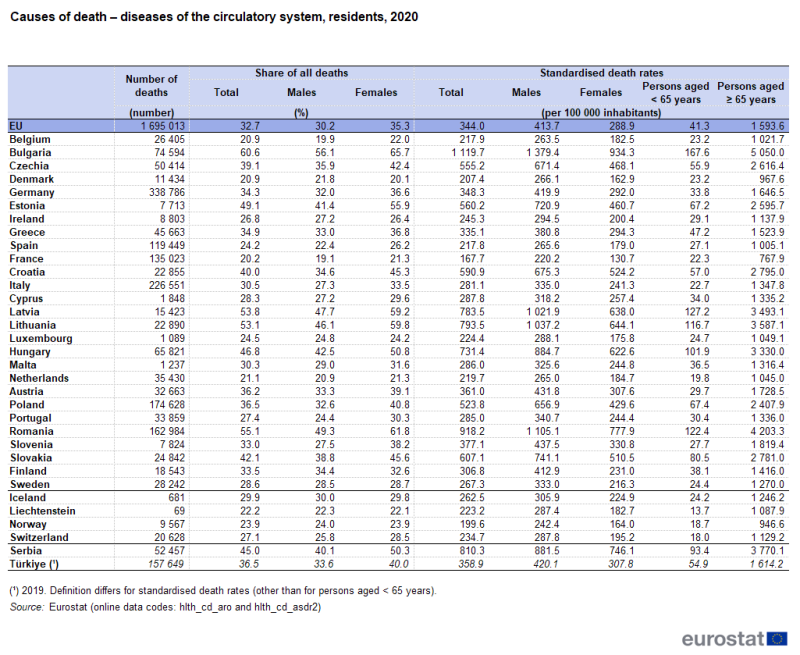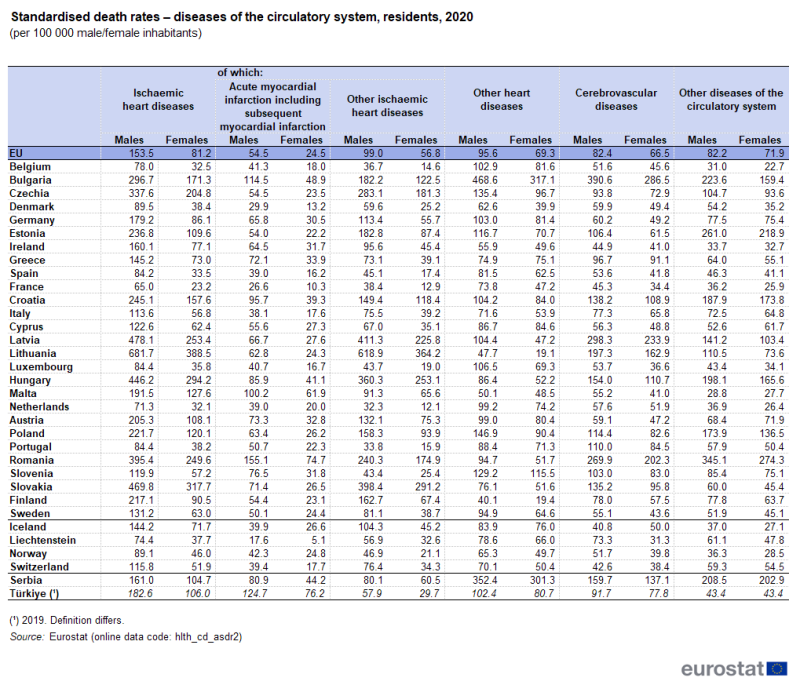Cardiovascular diseases statistics
Data extracted in September 2023.
Planned article update: 16 September 2024.
Highlights
Diseases of the circulatory system are the main cause of death in the EU, responsible for almost one-third (32.7 %) of all deaths in 2020.
The standardised death rate for cerebrovascular diseases in 2020 in Bulgaria (which had the highest rate among the EU Member States) was 8.4 times higher than France (which had the lowest rate).
37 200 heart bypasses were conducted in Germany in 2021; this was more than double the number in any of the other EU Member States (17 400 were conducted in France).
Hospital discharge rates for in-patients with diseases of the circulatory system, 2021
This article presents an overview of European Union (EU) statistics related to cardiovascular diseases and focuses on cardiovascular health and mortality, as well as cardiovascular healthcare.
Cardiovascular diseases are the leading cause of death in the EU. They cover a broad group of medical problems that affect the circulatory system (the heart and blood vessels), often resulting from atherosclerosis, the abnormal build-up of plaque – that is made of, among other constituents, cholesterol or fatty substances – deposited on the inside walls of a person's arteries. Some of the most common diseases that affect the circulatory system include ischaemic heart disease (heart attacks) and cerebrovascular diseases (strokes).
This article is 1 of a set of statistical articles concerning healthcare activities in the EU which forms part of an online publication on Health in the European Union – facts and figures.
Most of the data in this article relate to 2020 or 2021, although there are some data for earlier reference periods: as such, this article includes data that may have been impacted by the COVID-19 pandemic and its related restrictions. For this reason, particular attention should be paid when comparing the 2020 and/or 2021 data with data from earlier years.
In some EU Member States, healthcare systems were placed under intense pressure (particularly at the start of the pandemic) from an influx of patients with COVID-19. The pandemic also resulted in a range of knock-on effects including, among others, some services being curtailed/postponed due to the number of COVID-19 patients, staff shortages within hospitals and day care centres due to infection/quarantine procedures, and patients' hindered access to medical services due to their own infection/quarantine as well as lockdown or travel restrictions.
Full article
Deaths from cardiovascular diseases
There were 1.70 million deaths in the EU from diseases of the circulatory system
Diseases of the circulatory system place a considerable burden on healthcare systems and government budgets. Indeed, in 2020 there were 1.70 million deaths in the EU resulting from diseases of the circulatory system, which was equivalent to 32.7 % of all deaths. This percentage was considerably higher than the second most prevalent cause of death, cancer (malignant neoplasms; 22.5 % of all deaths).

Source: Eurostat (hlth_cd_aro) and (hlth_cd_asdr2)
Diseases of the circulatory system are one of the main causes of mortality in each of the EU Member States (as shown in Table 1): in 2020, they accounted for more than half of all deaths in Lithuania, Latvia and Romania, while the share was higher than two-fifths (60.6 %) in Bulgaria. By contrast, less than one-quarter of all deaths in Luxembourg, Spain, the Netherlands, Denmark, Belgium and France were caused by diseases of the circulatory system; France had the lowest share, at 20.2 %.
The largest gaps between the sexes were recorded in the three Baltic Member States as well as Romania, Croatia and Slovenia. In these EU Member States, the proportions of females dying from diseases of the circulatory system in 2020 were between 10.7 and 14.5 percentage points (pp) higher than those for males; these were the only EU Member States to report an imbalance of at least 10.0 pp. There were four EU Member States where a higher proportion of males (than females) died from diseases of the circulatory system: in Finland and Denmark, the shares of male deaths were 1.8 and 1.7 pp higher than those for females; smaller differences were observed in Ireland and Luxembourg.
Cyprus, the Netherlands, Malta and Belgium recorded the lowest gender differences in standardised death rates for diseases of the circulatory system
Standardised death rates are calculated as a weighted average of age-specific death rates and therefore improve comparability both over time and between countries. The EU's standardised death rate for diseases of the circulatory system was 344 deaths per 100 000 inhabitants in 2020, with the rate for males some 1.4 times as high as that for females.
Standardised death rates for diseases of the circulatory system were systematically higher for males than for females in 2020 across all of the EU Member States, although the differences between the sexes were relatively low compared with many other causes of death. The lowest absolute differences between males and females for standardised death rates for diseases of the circulatory system was recorded in Cyprus, at 61 deaths per 100 000 inhabitants; relatively small differences (just over 80 deaths per 100 000 inhabitants) were reported in the Netherlands, Malta and Belgium.
Deaths in younger ages can be considered as premature. Indeed, Table 1 shows that deaths from diseases of the circulatory system become more common at advanced ages. While this was true for the vast majority of causes of death, the standardised death rate for diseases of the circulatory system among those aged 65 years and over in the EU in 2020 was 39 times as high as the standardised death rate for persons aged less than 65 years; this can be compared with the same ratio for all causes of death, where the standardised death rate for those aged 65 years and over was 22 times as high as for persons aged less than 65 years. Note that the risk of females dying from diseases of the circulatory system before the age of 65 years was particularly low.
Within the EU as a whole, standardised death rates for males were consistently higher than those for females for all forms of diseases of the circulatory system
A more detailed analysis of causes of death for diseases of the circulatory system is presented in Table 2. EU standardised death rates for males in 2020 were higher than those for females for each of the six causes of death presented. For ischaemic heart diseases (codes I20–I25), the standardised death rate for males in the EU was 1.9 times as high as the corresponding rate for females. The difference between the sexes was less marked for other heart diseases (codes I30–I51), cerebrovascular diseases (codes I60–I69) and other diseases of the circulatory system (the remainder of codes I00–I99, not elsewhere covered).

(per 100 000 male/female inhabitants)
Source: Eurostat (hlth_cd_asdr2)
Some of the highest standardised death rates for ischaemic heart diseases were recorded in the Baltic Member States: Lithuania had the highest rate in 2020 for males (682 per 100 000 male inhabitants) and for females (389 per 100 000 female inhabitants), followed – in different orders for males and females – by Slovakia, Hungary, Latvia, Romania and Czechia. By contrast, the lowest standardised death rates for males and females were recorded in France, followed – again in different orders – by the Benelux Member States, Spain, Portugal and Denmark.
The standardised death rate for cerebrovascular diseases in Bulgaria was 8.4 times as high as the rate in France
In 2020, the highest standardised death rates for cerebrovascular diseases were recorded in Bulgaria, Latvia, Romania and Lithuania. By contrast, the lowest rates were recorded in France, Ireland and Luxembourg. As for all diseases of the circulatory system, there were large variations across the EU Member States in standardised death rates for cerebrovascular diseases in 2020, with the death rate in Bulgaria (where the highest rate was recorded) 8.4 times as high as that in France (where the lowest rate was registered).
Direct access to
Online publications
Causes of death
Healthcare activities
Methodology
General health statistics articles
Atlas
News releases
- Health (t_hlth), see:
- Causes of death (t_hlth_cdeath)
- Death due to other ischaemic heart diseases, by sex (tps00119)
- Death due to ischaemic heart diseases by NUTS 2 regions (tgs00059)
- Health (hlth), see:
- Health status (hlth_state)
- Self-reported chronic morbidity (hlth_srcm)
- Persons reporting a chronic disease, by disease, sex, age and educational attainment level (hlth_ehis_cd1e)
- Self-reported chronic morbidity (hlth_srcm)
- Health care (hlth_care)
- Health care activities (hlth_act)
- Hospital discharges - national data (hlth_hosd)
- Length of stay in hospital (hlth_hostay)
- Operations, procedures and treatment (hlth_oper)
- Health care activities (hlth_act)
- Causes of death (hlth_cdeath)
- General mortality (hlth_cd_gmor)
- Causes of death - deaths by country of residence and occurrence (hlth_cd_aro)
- Causes of death - standardised death rate by NUTS 2 region of residence (hlth_cd_asdr2)
- General mortality (hlth_cd_gmor)
Manuals and guidelines
Metadata
- Causes of death (SIMS metadata file – hlth_cdeath_sims)
- European health interview survey (ESMS metadata file – hlth_det_esms)
- Healthcare non-expenditure statistics (ESMS metadata file – hlth_res_esms)